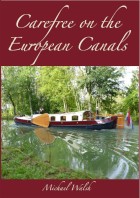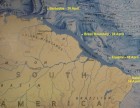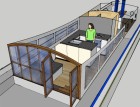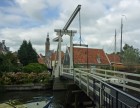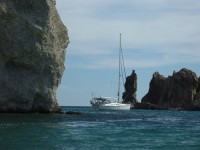Sequitur
Michael & Edi have headed out on a slow, thorough exploration of the globe.
| Vessel Name: | Sequitur and Zonder Zorg |
| Vessel Make/Model: | 2007 Hunter 49 and 1908 Wildschut Skûtsje |
| Hailing Port: | Vancouver, Canada |
| Crew: | Michael Walsh & Edi Gelin |
| About: | For our current location click, on Map & Tracking, then on the Google Earth logo. |
| Extra: | Follow us on Twitter: Follow @YachtSequitur |
| Social: |
13 January 2014
Another New Book Released
I am delighted to announce that my new book: Carefree on the European Canals is now in print and is available on Amazon.com, Amazon.ca [...]
26 April 2013
New Book Released
The proof copy of my new book arrived by courier today. I have approved it and it is now listed on Amazon for pre-order, with a publication date of 30 April. It is a rather large book at 680 pages in an 8.5 by 11 inch format with 315,000 words illustrated by over 2400 colour photos, charts and maps. [...]
24 April 2013
One Year Out of Brazil
One year ago today we sailed Sequitur out of Brazil after enduring more than six weeks in the least-friendly country that we had experienced during our three-year voyage. In the early evening of 24 April 2012 we crossed the line on the chart dividing Brazil from French Guyana and breathed a huge sigh [...]
27 October 2012 | Harlingen, Friesland
Planing a Metamorphosis
We have added a new post to the Zonder Zorg blog at: Planing a Metamorphosis.
29 September 2012 | Sneek, Netherlands
Onward to Friesland
We have arrived in Friesland and have added a new post to the skûtsje's blog at: Onward to Friesland
19 September 2012 | Hoorn, Netherlands
North From Aalsmeer
We have moved northward from Aalsmeer and I have added two new posts: Heading North From Aalsmeer and North From Amsterdam
13 September 2012 | Aalsmeer, Netherlands
Taking Possession
We are back in the Netherlands, and I have added some new posts to the ZonderZorg blog at: Taking Possession and Settling-In and Making Plans
20 August 2012 | Sequitur: St Augustine, USA - Michael & Edi: Vancouver, Canada - Nieuwe Zorg: Aalsmeer, Netherlands
Added a New Website
We have added a new website: Skûtsje ZonderZorg. Zonder zorg in Dutch means without worry. Our intention with the site is to provide a place to share some of the history, geography and culture of the skûtsje as we discover it. We will also use this place to document [...]
11 August 2012 | Sequitur: St Augustine, USA - Michael & Edi: Vancouver, Canada - Nieuwe Zorg: Aalsmeer, Netherlands
Still More Skûtsje History
We continued to attempt to track-down Douwe Albert Visser, who was the owner of Nieuwe Zorg in 1941 when she was re-registered. One of the problems we repeatedly encountered in our online searches was the effect of currently having Albert Visser and two Douwe Vissers as very competitive skûtsje racers, [...]
10 August 2012 | Sequitur: St Augustine, USA - Michael & Edi: Vancouver, Canada - Nieuwe Zorg: Aalsmeer, Netherlands
Some More Skûtsje History
While I was researching the history of Nieuwe Zorg, I finally found her first registration details obscured by an apparent typographical error in a transcribed online spreadsheet. She was listed as having been built in 1901 instead of 1908. I emailed the webmaster of the [...]
Across the Sea of Cortez
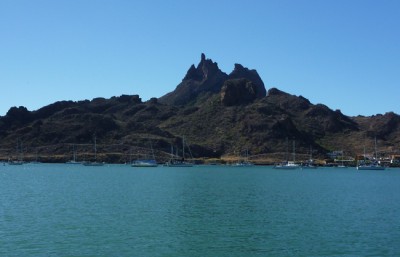
It had rained again overnight, and we motored out under an overcast of nimbo-stratus, reminiscent of Vancouver this time of year. It was a bleak, cool morning, and for the first time in two months, we put on fleece and foul weather jackets. The winds had been in the 30 to 35 knot range the last couple of days, and we were prepared for the residual 2 to 3 metre northwesterly swell. As we left the land's influence, the winds settled in around 10 knots from the west-southwest.
Our destination was San Carlos, 74 miles across the Sea of Cortez on the Mexican mainland. The wind was directly in our stern, but not strong enough to give us the 7 knots we needed to make a daylight crossing and arrive in San Carlos before dark, so I put revolutions on the engine for 7 knots. The swell was running onto our port quarter, giving us a rather sloppy motion, so we pulled out the sails to add some stability and a small boost. We surged and slowed and surfed and wallowed with the rhythms of the swells as they carried us along and we watched the log bounce back and forth between 5.5 and 11 knots.
Mid afternoon, the sun began to break its way through the clouds, but by the time we arrived at the entrance to San Carlos at 1630, it had long since disappeared in dark clouds building to the west. We had averaged 8 knots on the crossing, assisted a bit by the light following winds, but mostly by the push of the swell.

The first thing we noticed as we entered Bahia San Carlos was the number of boats at anchor and on mooring balls. There were many dozens of them. The next thing we noticed was a sailboat washed up on the shore, then another, and another, and another. Within a couple of hundred metres there were four sailboats, quite apparently freshly washed ashore. We later learned there had been winds in the mid-fifty knot range earlier in the day.
We took a circuit around the bay, looking for a place to anchor, but found them quite scarce; any spaces not currently occupied by boats were occupied by private mooring balls. Eventually, at 1720 we came to 21 metres on the Rocna in 6 metres of water in the southwestern lobe of the bay. The boats freshly dragged ashore just a cable or so away from us helped ensure we carefully and securely anchored.
It had been a tiring crossing; the uneven motion of the sloppy seas and the damp cold we thought we had left behind in the winters of British Columbia, seemed to wear us down more than usual. We had also gotten up earlier than normal, so we had a nice vegetable omelette for dinner and were in bed by 2300.

It rained very heavily overnight and on into Saturday morning, so we remained onboard relaxing and puttering until mid afternoon, when the showers stopped and the sun began peeking through the clouds. We launched the dinghy and took a circuit along the western shore looking at the boats aground. Two of them, a ketch and a sloop were well-found and apparently loved, while two others without rigs looked to have been derelict unfulfilled dreams.

There were also the fresh remains some runabouts, three or four of them, but hard to tell from the scattered pieces. As we were looking at the last of the boats on the western shore, we spotted another washed-up sloop in the northeastern part of the bay.

As we approached, we saw that there was an attempt in progress to haul her off the rocks. There was a line two-thirds of the way up her mast, which led to an anchored Vessel Assist launch, which had apparently already flopped the boat from her port side on the rocks, to her starboard side to seaward. We sat in the dinghy thirty or so metres away, watching as a diver and a crew in a runabout secured lines to the boat.

Then, as the launch hauled on the line on the mast, the powerful outboard of the runabout hauled on a line on the sloop's stern, and Dream Catcher slid easily and gently into the deeper water.
We continued on our slow circuit and headed into Marina San Carlos, and eventually found the dinghy dock. As we were landing, we saw two men standing on the float looking expectantly. One offered a hand landing, and Edi asked, jokingly, if they were waiting for their ship to come in. They said yes, just as we all saw the Vessel Assist launch bringing Dream Catcher around the end of the finger and in toward the float.
I told Dream Catcher's owner that I had shot a video and several dozen photos of the re-launching, and gave him our card so he could contact us. We explored the marina complex, its attendant shops and the businesses in the surrounding area, and then went back out to Sequitur. In the evening Edi made up four loaves of bread to rise overnight.
After Edi punched-down the bread on Sunday morning, we took the dinghy to the marina and headed off in search for a place to have breakfast. The first place in the marina building was way too casual for me, and being so close to the boats, it was too expensive. We passed on another spot in the shops along the marina side, and then around the corner, we rejected a pompous-looking place with a breakfast buffet. We left the marina complex and crossed the street to climb the stairs to a promising-looking place, but were immediately blasted back out the door by a live quartet playing very loud breakfast music. We walked along to Club de Capitanes to find a bleary-eyed fellow telling us he had just arrived and was not yet set-up. We finally settled on a rather tacky looking place called Tequilas, whose interior was decorated with an improbable jumble of faded fishing photos, framed magazine or calendar clippings of Italian city scenes and some failed attempts at primitive art. We had our first ham and eggs breakfast in many months. Two good sized slices of ham, two eggs, hash browns that tasted more like McCains than fresh, and two triangles of toast with coffee and refills came to just under $7.00 each, including the tip.

After breakfast we caught a bus into Guaymas, a city of 130,000 about 25 kilometres to the south. The half-hour ride cost 12 pesos, just under a dollar, and we got off as the bus turned inland from the waterfront near the Monumento al Pescador.
We walked the short distance over to the new Singlar marina, and found the office closed, though the sign on the door showed it to be open 0900 to 1700 seven days a week. It is a new facility, having been completed less than three years ago, and we had wanted to inquire about moorage. There appeared to be several vacancies among the two dozen or so slips. We also saw that there is a good anchorage adjacent to the facility, but we could see no dinghy dock, nor any easily usable landing place anywhere nearby.

We walked through the streets adjacent to the port and saw many failed businesses and abandoned buildings. In a couple of places there were up-wellings of grey water from obviously broken sewer lines, and the streets for several blocks were running and puddled with pungent water. This corner of the city is obviously not the current prosperous one, though the architecture and quality of construction of the derelict buildings spoke to us of a much better time, of a time when this area would have been rather upscale.

We walked along to the 18th century church, Iglesia de San Fernando. Through broken windows, we could see that the roof had collapsed, and was being repaired. We heard the muffled drone of an amplified voice and saw a priest with a microphone pressed too closely to his mouth, conducting Mass in the gardens beside the church. In front of the church is a park, the centrepiece of which is an ornate cast iron gazebo reputed to have been built in the late 1800s by Gustave Eiffel.
We walked back to the corner where the bus had dropped us, and waited for the next one back to San Carlos. On the way back, we noted the locations of the Soriana and Casa Ley supermarkets, which we need to visit to re-stock our larders in the next few days.
Back onboard we baked the four loaves of bread one at a time. Either our cast iron Dutch oven is too large or our galley oven is too small for baking more than one at a time, so we have developed a nice routine:
- Heat oven and covered pot to 450;
- Put first loaf in covered pot for 30 minutes;
- Remove lid and bake another 20 minutes;
- Dump loaf onto cooling rack and replace with next loaf;
- Repeat baking process;
- Slice off a piece from the freshly baked loaf and sample;
- Repeat process; and
- Delay dinner because we've just eaten four slices of bread.

